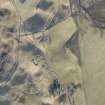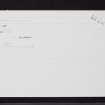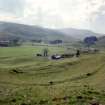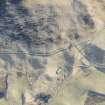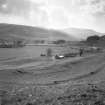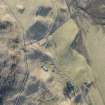Pricing Change
New pricing for orders of material from this site will come into place shortly. Charges for supply of digital images, digitisation on demand, prints and licensing will be altered.
Glen Shee, Cambs
Lime Kiln (18th Century) - (19th Century), Township (Medieval) - (Post Medieval)
Site Name Glen Shee, Cambs
Classification Lime Kiln (18th Century) - (19th Century), Township (Medieval) - (Post Medieval)
Canmore ID 29638
Site Number NO17SW 46
NGR NO 1149 7028
Datum OSGB36 - NGR
Permalink http://canmore.org.uk/site/29638
- Council Perth And Kinross
- Parish Kirkmichael (Perth And Kinross)
- Former Region Tayside
- Former District Perth And Kinross
- Former County Perthshire
Field Visit (12 August 1987)
Disposed on the slopes round the 19th-century cottage at Cambs there are the remains of a fermtoun comprising at least fifteen buildings, enclosures and a kiln (NO 1149 7032 - NO 1152 7024).
The fermtoun is depicted by Roy (1747-55, sheet 18/4) and is named Canus; it is Cambus on Stobie (1783) as too on Ainslie (1794) but on Brown's 1808 survey it appears as Cammis. Brown provides considerable detail of the buildings, enclosures, yards and surrounding fields; also shown are a number of outbuildings to the S of the present cottage of which there are now no visible remains. The adjoining field on the S is described as the 'Well Field'. By this date the fermtoun was largely abandoned. The site can be divided as follows:
A. NO 1145 7026 Beside the track and end-on to Cambs cottage there are the remains of a rectangular building (11.6m from E to W by 4.6m transversely over stone wall-footings 0.9m thick), the S wall of which has been reduced by robbing. To the rear and parallel to the cottage there is a second building (NO 1143 7027) which appears to be open-ended on the SE. This measures 8.5m from NW to SE by 4.4m transversely over stone wall-footings 0.9m in thickness. A third building (NO 1142 7028), end-on to the second, and overlain by the wall of a more recent enclosure, measures 6.1m from NW to SE by 4.3m transversely over stone wall-footings 1m in thickness and up to 0.5m in average height; the NW wall immured by the later enclosure is up to 1.2m in height.
B. To the N, NNE and NE of (A) there are three yards which are adjoined and make use of the natural depressions in the hillslope. At the ESE terminal of the first (at NO 1141 7030) a slight rectangular depression (8.5m from NW to SE by 3.7m transversely) may be the site of a building which has been terraced into the slope. At the head of the second yard (NO 1141 7032) there are the remains of a substantial three-compartment rectangular building (16.9m from SE to NW by up to 4.7m transversely over turf-covered stone wall-footings spread up to 1.2m thick). The yard (27.8m by up to 21.3m) is enclosed by a low bank. On the E (at NO 1142 7031) there are the wasted remains of what may be a rectangular building which is set end-on to the slope (8.4m from NW to SE by 3.7m transversely over spread stone wall-footings). At the rear of the third yard (NO 1143 7033), a shallow subrectangular depression (8.4m from E to W by 3.2m overall) may be the site of another building.
C. The head-dyke abuts the E angle of the third yard; immediately to the ENE a kink in its course may define the site of a building which would have stood end-on to another (at NO 1145 7033) measuring 6.5m from SW to NE by 3.3m transversely over stone wall-footings up to 0.9m in thickness. At right angles to the latter and end-on to the head-dyke there are the remains of a two-compartment rectangular building (16.3m from NW to SE by 4.2m transversely over turf-covered stone wall-footings 0.9m thick) with an outshot on the SE (7.8m by 4.3m) and a yard (18m by 12m) on the SW. Some 18m to the NNE (at NO 1146 7035), a substantial rectangular building (15.2m from N to S by 5.9m transversely overall) is now indicated only by the wasted remains of its end-walls; that on the N, incorporated in the head-dyke, is round-ended. To the SE (NO 1148 7034) there is a more well-preserved building (9.1m from SE to NW by 4.2m transversely over stone wall-footings 0.9m thick).
D. NO 1146 7028 To the E of Cambs cottage there are the turf-covered remains of a building with a yard on its SSW side. It has been terraced into the slope and measures 11m from SE to NW by 3.9m transversely overall; the yard measured 10.4m by 11m internally. To the SE and set at an awkward angle across the slope (at NO 1146 7026) there are the wasted remains of a two-compartment building (15.9m from SE to NW by 3.5m transversely over turf-covered stone wall-footings up to 0.8m thick); each compartment was probably entered from the SW.
E. NO 1150 7025 The remains of a two-compartment rectangular building lie across the open end of a deeply sculptured natural hollow that is skirted by a track; one branch of which leads to the buildings (C) on the higher terrace. The building, which has been located on a slight ridge and is in part terraced end-on into the slope, measures 18.5m from W to E by 5.5m transversely over turf-covered stone wall-footings spread up to 1.2m in thickness. On the E it may overlie the remains of an earlier building, possibly also of two compartments (at least 7m by 5.5m overall), though the remains could be those of an outshot. On the N there is a yard defined by a low turf bank (26m by up to 12m). On the E, and set back into the slope (at NO 1152 7024), there are the wasted remains of a kiln (6.3m by 3.3m overall). The bowl (3.3m in diameter) was on the S; the flue on the N.
Upslope, beside the old track and close to the boundary fence (at NO 1159 7023), a subrectangular depression (7.5m from E to W by 4m transversely) may mark the site of a further building.
Visited by RCAHMS (IMS) 12 August 1987
RCAHMS 1990
Note (27 November 1997)
NO17SW 46 1149 7028
One unroofed, five roofed buildings, three enclosures, a lime kiln and a head-dyke are depicted on the 1st edition of the OS 6-inch map (Perthshire 1865-7, sheet xxiv). One roofed, one unroofed building, one enclosure and part of the head-dyke are shown on the current edition of the OS 1:10000 map (1973).
Information from RCAHMS (SAH) 27 November 1997.













